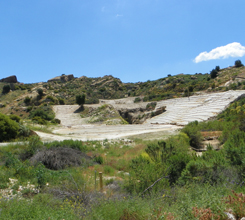 |
RESTORATION, MONITORING & MANAGEMENT
Making utility landscapes more pollinator-friendly:
Integrative Vegetation Management (IVM) is a technique used by utility companies to combat weeds, invasive species, and manage landscapes to help minimizes negative environmental impacts. Many of these techniques can create a landscape that is also good for pollinators. Pollinator Partnership (P2) is working with local utilities in California to fine-tune IVM techniques to create truly pollinator-friendly systems.
Integrating pollinator conservation into soil and water treatment systems:
Native plants are often used in restoration and remediation ecology to stabilize hillsides, prevent soil erosion, and help naturally filter water. Environmental restoration programs can have a lot more benefit if important pollinator-attractive species are integrated into their design. P2 is actively targeting both pollinator conservation and landscape restoration at a large restoration site in Southern California.
Creating monarch butterfly habitat in key migration zones:
Monarch butterflies undertake an epic migration as they fly from Southern Canada into Northern Mexico. Unfortunately, this migration is threatened due to habitat loss in key overwintering location. In an effort to help monarchs find sites to feed and rest along their journey, P2 is restoring habitat by planting milkweeds and nectar plants at corporate and industrial landscapes.
Monitoring the pollinators of threatened and endangered plant species:
Understanding the pollinator systems of threatened plants is essential to survival and restoration plans. In Southern California, P2 is studying the pollinator associations of the federally listed Braunton’s milkvetch (Astragalus brauntonii) and the locally endemic and threatened Los Angeles species Santa Susana Tar Plant (Deinandra minthornii). A key element of this study is the impact of pollinator visits on seed viability and how overall landscape-level management and conservation can help local plant populations.
|
 A reseeded hillside is part of a landscape restoration program in Southern California.
A reseeded hillside is part of a landscape restoration program in Southern California.
|

